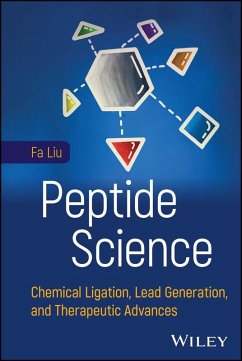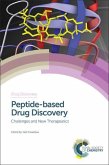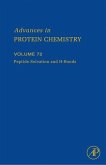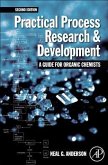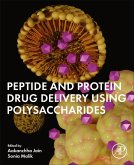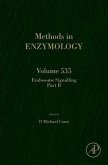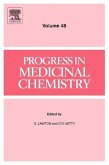F LiuChemical Ligation, Lead Generation, and Therapeutic Advances
Peptide Science
Chemical Ligation, Lead Generation, and Therapeutic Advances
Herausgeber: Liu, Fa
F LiuChemical Ligation, Lead Generation, and Therapeutic Advances
Peptide Science
Chemical Ligation, Lead Generation, and Therapeutic Advances
Herausgeber: Liu, Fa
- Gebundenes Buch
- Merkliste
- Auf die Merkliste
- Bewerten Bewerten
- Teilen
- Produkt teilen
- Produkterinnerung
- Produkterinnerung
Understand the nature and applications of peptides with this clear and comprehensive guide Peptides are signaling molecules comprised of amino acids which play an important role in modulating certain physiological processes. They have a wide range of applications, particularly with respect to biological studies and therapeutical potentials. The explosive growth of peptide science in recent years and the variety of achievements in peptide drug discovery and related areas have made it an important area of study for new researchers and industry professionals. Peptide Science offers a clear,…mehr
Andere Kunden interessierten sich auch für
![Peptide-Based Drug Discovery Peptide-Based Drug Discovery]() Peptide-Based Drug Discovery221,99 €
Peptide-Based Drug Discovery221,99 €![Peptide Solvation and H-Bonds Peptide Solvation and H-Bonds]() Robert Baldwin / David Baker (Volume ed.)Peptide Solvation and H-Bonds123,99 €
Robert Baldwin / David Baker (Volume ed.)Peptide Solvation and H-Bonds123,99 €![Practical Process Research and Development - A Guide for Organic Chemists Practical Process Research and Development - A Guide for Organic Chemists]() Neal G. AndersonPractical Process Research and Development - A Guide for Organic Chemists86,99 €
Neal G. AndersonPractical Process Research and Development - A Guide for Organic Chemists86,99 €![Peptide and Protein Drug Delivery Using Polysaccharides Peptide and Protein Drug Delivery Using Polysaccharides]() Peptide and Protein Drug Delivery Using Polysaccharides155,99 €
Peptide and Protein Drug Delivery Using Polysaccharides155,99 €![Endosome Signaling Part B Endosome Signaling Part B]() Endosome Signaling Part B133,99 €
Endosome Signaling Part B133,99 €![Progress in Medicinal Chemistry Progress in Medicinal Chemistry]() Progress in Medicinal Chemistry143,99 €
Progress in Medicinal Chemistry143,99 €![Turn on and Tune in Turn on and Tune in]() John MannTurn on and Tune in39,99 €
John MannTurn on and Tune in39,99 €-
-
-
Understand the nature and applications of peptides with this clear and comprehensive guide Peptides are signaling molecules comprised of amino acids which play an important role in modulating certain physiological processes. They have a wide range of applications, particularly with respect to biological studies and therapeutical potentials. The explosive growth of peptide science in recent years and the variety of achievements in peptide drug discovery and related areas have made it an important area of study for new researchers and industry professionals. Peptide Science offers a clear, systematic overview of this burgeoning field and its major applications. Covering the chemistry, the pertinent technologies, and major existing therapies, it provides the tools required to integrate peptide research with virtually any area of research and development. Fully cognizant of the latest technological advances, it's a must-own for anyone looking to understand a vital field of chemistry. Peptide Science readers will also find: * Through coverage of peptide hit generation technologies from nature, to various display libraries and to modern computational designs * Detailed discussion of therapies for conditions including cancer, diabetes, infectious diseases, and more * A section dedicated to key challenges and future directions in peptide therapeutics Peptide Science is ideal for industry professionals and researchers in organic chemistry, peptide science/chemistry, protein chemistry, biochemistry, and pharmaceutical sciences.
Produktdetails
- Produktdetails
- Verlag: John Wiley & Sons Inc
- Seitenzahl: 544
- Erscheinungstermin: 15. Juli 2025
- Englisch
- Abmessung: 232mm x 160mm x 35mm
- Gewicht: 978g
- ISBN-13: 9781119824671
- ISBN-10: 1119824672
- Artikelnr.: 71913692
- Herstellerkennzeichnung
- Libri GmbH
- Europaallee 1
- 36244 Bad Hersfeld
- gpsr@libri.de
- Verlag: John Wiley & Sons Inc
- Seitenzahl: 544
- Erscheinungstermin: 15. Juli 2025
- Englisch
- Abmessung: 232mm x 160mm x 35mm
- Gewicht: 978g
- ISBN-13: 9781119824671
- ISBN-10: 1119824672
- Artikelnr.: 71913692
- Herstellerkennzeichnung
- Libri GmbH
- Europaallee 1
- 36244 Bad Hersfeld
- gpsr@libri.de
Fa Liu, PhD, is the CSO of Full-Life Technologies, which centers on targeted alpha-radionuclide therapies. Prior to joining Full-Life, he was the CEO and Co-founder of Focus-X Therapeutics (2020-2022), later acquired by Full-Life. Before founding Focus-X, Dr. Liu headed the Chemistry of Novo Nordisk US sites, and Calibrium LLC (acquired by Novo Nordisk) (2014-2020), and served as a Group Leader at the Eli Lilly Peptide Discovery (2009-2014). Prior to Lilly, Dr. Liu worked at National Cancer Institute as a Staff Scientist (2004-2009). He received his Ph.D. in Synthetic Organic Chemistry from Shanghai Institute of Organic Chemistry in 2004.
List of contributors xiii
Preface xvii
Section I New Developments in Peptide Chemistry 1
1 Chemical Peptide Ligations 3
Yihui Cao and Xuechen Li
1.1 Introduction 3
1.2 Ligation Driven by Trans-esterification 4
1.3 Ligation Driven by Imine Capture 8
1.4 Ligation Initiated by Hydroxylamine 10
1.5 Ligation in Protein Synthesis 12
1.6 Ligations in Drug Development 17
1.7 Summary and Outlook 21
2 Protein and Peptide Ligation Using Peptide Ligases 29
Anna Koijen and Leendert J. van den Bos
2.1 Introduction 29
2.2 Peptide Ligases Mechanism of Action 32
2.3 Sortase 33
2.4 Peptide Asparaginyl Ligases 38
2.5 Subtilisin-derived Peptide Ligases 41
2.6 Trypsiligase 44
2.7 Conclusion 46
3 Modern Methods for Late-stage Peptide Modification 55
Yuxuan Ding and Zachary T. Ball
3.1 Introduction 55
3.2 Methionine 57
3.3 Aspartate and Glutamate 59
3.4 Arginine 61
3.5 Tryptophan 62
3.6 Functionalization of sp2 C-H Bonds: Tyr, Phe, and His 66
3.7 Functionalization of sp3 C-H Bonds 71
3.8 Other X-H Functionalizations 73
3.9 Conclusion 74
Section II Peptide Drug Hit Identification 87
4 Generating Phage Libraries Bearing Unnatural Pharmacophores 89
Christin Kossmann, Arunika Ekanayake and Ratmir Derda
4.1 Introduction 89
4.2 Biotin Capture Assay to Detect Chemical Modification of Phage Libraries
93
4.3 N-terminal Oxidation and Functionalization to Incorporate Unnatural
Fragments 106
4.4 Macrocyclization of Phage-displayed Peptides Bearing Cysteines 110
4.5 Macrocyclization and Installation of Warheads in Phage-displayed
Libraries 114
4.6 Outlook 120
5 Computational Peptide Design for Diverse Structures and Functions 127
Stephen Rettie, David Juergens and Gaurav Bhardwaj
5.1 The Various Types of Peptides 128
5.2 In Silico Peptide Design: From Physics-based Methods to DL 129
5.3 Physics-based Methods 130
5.4 DL Methods for Peptide Design 136
5.5 Optimizing for Membrane Permeability and Stability 140
5.6 Remaining Challenges 141
5.7 Conclusion 143
Section III Peptide Drug Lead Generation and Optimization 151
6 Peptide Discovery: Lead Generation 153
Yvonne Angell, Wendy Hartsock, Hans Melo and Timothy M. Reichart
6.1 Introduction 153
6.2 Approved Drugs Discovered Through Phage Display 174
6.3 Approved Drugs Discovered Through mRNA Display 177
6.4 A Successful Example 185
6.5 Conclusion 188
7 A Survey and Guide to the Development of Fatty Acid-derivatized Peptide
Therapeutics 203
Michael T. Jacobsen, Christian Poulsen, Katharina L. Kopp, Jørgen Olsen and
Nick Cox
7.1 Introduction 203
7.2 Basics of Fatty Acid Derivatization of Peptides 204
7.3 Evolution of GLP-1-based Incretins into Stable, Long-acting
Therapeutics 205
7.4 Diverse Mechanisms of Fatty Acid Derivatization to Extend Insulin
Half-life 210
7.5 Development of a Stable, Fatty Acid-derivatized Amylin Analog 214
7.6 Stabilization and Fatty Acid Derivatization of Peptide YY (PYY) 217
7.7 Guidance for Advancing Fatty Acid-derivatized Peptides 222
7.8 Concluding Remarks 242
Section IV Peptide Drug Case Studies 269
8 Insulin in Its Second Century: History, Evolution, and Aspirations 271
John P. Mayer, Kishore Thalluri, Ethan Mickelson, Michael H.B. Stowell and
Richard D. DiMarchi
8.1 Introduction 271
8.2 The Evolution of Insulin Therapy 272
8.3 Structure 278
8.4 Synthesis 280
8.5 Aspirational Aims 286
8.6 Concluding Thoughts 290
9 Incretins and Development of Incretin-based Therapeutics 305
Nan Zheng, Xiao-xuan Su, Shengping Zhang and Weijun Shen
9.1 Introduction 305
9.2 Development of Novel GLP-1 and GIP-based Therapeutics 309
9.3 Development of Multi-receptor Agonists Targeting Incretin and Other
Hormonal Receptors 315
9.4 Summary and Perspective 329
10 Peptide-based Therapeutics for Inflammatory and Autoimmune Diseases 339
Sunay V. Chankeshwara, Werngard Czechtizky and Wu Su
10.1 Introduction 339
10.2 Literature Search and Methods 341
10.3 Representative Anti-inflammatory Peptides in Clinical Trials 342
10.4 Summary and Discussion 351
11 Radioligand as a Unique Rising Modality for Cancer Diagnosis and
Treatment 359
Ming-Jin Jheng, Xiaozhu Wang, Pengyun Li and Fa Liu
11.1 Radioligand Introduction 359
11.2 Radionuclides and Chelators Developed for Medical Imaging and Cancer
Treatment 361
11.3 Notable Radioligands Developed for Cancer Diagnosis and Treatment 364
11.4 Emerging Targets 371
11.5 Emerging Binder Modalities as Radioligand Vector 379
11.6 Perspectives: Promises and Challenges 384
12 Peptide-small Molecule Drug Conjugates for Cancer, Metabolic Diseases,
and Beyond 401
Rongjun He, Sumeet Singh and Adam Mezo
12.1 Introduction 401
12.2 Peptide-drug Conjugates for Cancer 402
12.3 Peptide-drug Conjugates for Metabolic Diseases 409
12.4 Peptide-drug Conjugates for Other Diseases 415
12.5 Challenges in Peptide-drug Conjugate Design 415
12.6 Summary 416
13 Emerging Landscape of Therapeutic Oligonucleotide Delivery by
Cell-penetrating Peptide 425
Xiang Li, Xiulong Shen, Ashweta Sahni and Ziqing Qian
13.1 Introduction 425
13.2 Cell-penetrating Peptides 426
13.3 Applications of CPPs for the Delivery of Therapeutic Oligonucleotides
433
13.4 Future Perspectives and Summary 447
Section V Peptide CMC and Regulatory 469
14 Peptides Chemistry, Manufacturing, and Controls 471
Jack Xu
14.1 Introduction 471
14.2 CMC Information and Format for DS 472
14.3 CMC Information and Format for DP 477
14.4 Synthetic Peptide CMC Development 483
14.5 Conclusions 504
Index 509
Preface xvii
Section I New Developments in Peptide Chemistry 1
1 Chemical Peptide Ligations 3
Yihui Cao and Xuechen Li
1.1 Introduction 3
1.2 Ligation Driven by Trans-esterification 4
1.3 Ligation Driven by Imine Capture 8
1.4 Ligation Initiated by Hydroxylamine 10
1.5 Ligation in Protein Synthesis 12
1.6 Ligations in Drug Development 17
1.7 Summary and Outlook 21
2 Protein and Peptide Ligation Using Peptide Ligases 29
Anna Koijen and Leendert J. van den Bos
2.1 Introduction 29
2.2 Peptide Ligases Mechanism of Action 32
2.3 Sortase 33
2.4 Peptide Asparaginyl Ligases 38
2.5 Subtilisin-derived Peptide Ligases 41
2.6 Trypsiligase 44
2.7 Conclusion 46
3 Modern Methods for Late-stage Peptide Modification 55
Yuxuan Ding and Zachary T. Ball
3.1 Introduction 55
3.2 Methionine 57
3.3 Aspartate and Glutamate 59
3.4 Arginine 61
3.5 Tryptophan 62
3.6 Functionalization of sp2 C-H Bonds: Tyr, Phe, and His 66
3.7 Functionalization of sp3 C-H Bonds 71
3.8 Other X-H Functionalizations 73
3.9 Conclusion 74
Section II Peptide Drug Hit Identification 87
4 Generating Phage Libraries Bearing Unnatural Pharmacophores 89
Christin Kossmann, Arunika Ekanayake and Ratmir Derda
4.1 Introduction 89
4.2 Biotin Capture Assay to Detect Chemical Modification of Phage Libraries
93
4.3 N-terminal Oxidation and Functionalization to Incorporate Unnatural
Fragments 106
4.4 Macrocyclization of Phage-displayed Peptides Bearing Cysteines 110
4.5 Macrocyclization and Installation of Warheads in Phage-displayed
Libraries 114
4.6 Outlook 120
5 Computational Peptide Design for Diverse Structures and Functions 127
Stephen Rettie, David Juergens and Gaurav Bhardwaj
5.1 The Various Types of Peptides 128
5.2 In Silico Peptide Design: From Physics-based Methods to DL 129
5.3 Physics-based Methods 130
5.4 DL Methods for Peptide Design 136
5.5 Optimizing for Membrane Permeability and Stability 140
5.6 Remaining Challenges 141
5.7 Conclusion 143
Section III Peptide Drug Lead Generation and Optimization 151
6 Peptide Discovery: Lead Generation 153
Yvonne Angell, Wendy Hartsock, Hans Melo and Timothy M. Reichart
6.1 Introduction 153
6.2 Approved Drugs Discovered Through Phage Display 174
6.3 Approved Drugs Discovered Through mRNA Display 177
6.4 A Successful Example 185
6.5 Conclusion 188
7 A Survey and Guide to the Development of Fatty Acid-derivatized Peptide
Therapeutics 203
Michael T. Jacobsen, Christian Poulsen, Katharina L. Kopp, Jørgen Olsen and
Nick Cox
7.1 Introduction 203
7.2 Basics of Fatty Acid Derivatization of Peptides 204
7.3 Evolution of GLP-1-based Incretins into Stable, Long-acting
Therapeutics 205
7.4 Diverse Mechanisms of Fatty Acid Derivatization to Extend Insulin
Half-life 210
7.5 Development of a Stable, Fatty Acid-derivatized Amylin Analog 214
7.6 Stabilization and Fatty Acid Derivatization of Peptide YY (PYY) 217
7.7 Guidance for Advancing Fatty Acid-derivatized Peptides 222
7.8 Concluding Remarks 242
Section IV Peptide Drug Case Studies 269
8 Insulin in Its Second Century: History, Evolution, and Aspirations 271
John P. Mayer, Kishore Thalluri, Ethan Mickelson, Michael H.B. Stowell and
Richard D. DiMarchi
8.1 Introduction 271
8.2 The Evolution of Insulin Therapy 272
8.3 Structure 278
8.4 Synthesis 280
8.5 Aspirational Aims 286
8.6 Concluding Thoughts 290
9 Incretins and Development of Incretin-based Therapeutics 305
Nan Zheng, Xiao-xuan Su, Shengping Zhang and Weijun Shen
9.1 Introduction 305
9.2 Development of Novel GLP-1 and GIP-based Therapeutics 309
9.3 Development of Multi-receptor Agonists Targeting Incretin and Other
Hormonal Receptors 315
9.4 Summary and Perspective 329
10 Peptide-based Therapeutics for Inflammatory and Autoimmune Diseases 339
Sunay V. Chankeshwara, Werngard Czechtizky and Wu Su
10.1 Introduction 339
10.2 Literature Search and Methods 341
10.3 Representative Anti-inflammatory Peptides in Clinical Trials 342
10.4 Summary and Discussion 351
11 Radioligand as a Unique Rising Modality for Cancer Diagnosis and
Treatment 359
Ming-Jin Jheng, Xiaozhu Wang, Pengyun Li and Fa Liu
11.1 Radioligand Introduction 359
11.2 Radionuclides and Chelators Developed for Medical Imaging and Cancer
Treatment 361
11.3 Notable Radioligands Developed for Cancer Diagnosis and Treatment 364
11.4 Emerging Targets 371
11.5 Emerging Binder Modalities as Radioligand Vector 379
11.6 Perspectives: Promises and Challenges 384
12 Peptide-small Molecule Drug Conjugates for Cancer, Metabolic Diseases,
and Beyond 401
Rongjun He, Sumeet Singh and Adam Mezo
12.1 Introduction 401
12.2 Peptide-drug Conjugates for Cancer 402
12.3 Peptide-drug Conjugates for Metabolic Diseases 409
12.4 Peptide-drug Conjugates for Other Diseases 415
12.5 Challenges in Peptide-drug Conjugate Design 415
12.6 Summary 416
13 Emerging Landscape of Therapeutic Oligonucleotide Delivery by
Cell-penetrating Peptide 425
Xiang Li, Xiulong Shen, Ashweta Sahni and Ziqing Qian
13.1 Introduction 425
13.2 Cell-penetrating Peptides 426
13.3 Applications of CPPs for the Delivery of Therapeutic Oligonucleotides
433
13.4 Future Perspectives and Summary 447
Section V Peptide CMC and Regulatory 469
14 Peptides Chemistry, Manufacturing, and Controls 471
Jack Xu
14.1 Introduction 471
14.2 CMC Information and Format for DS 472
14.3 CMC Information and Format for DP 477
14.4 Synthetic Peptide CMC Development 483
14.5 Conclusions 504
Index 509
List of contributors xiii
Preface xvii
Section I New Developments in Peptide Chemistry 1
1 Chemical Peptide Ligations 3
Yihui Cao and Xuechen Li
1.1 Introduction 3
1.2 Ligation Driven by Trans-esterification 4
1.3 Ligation Driven by Imine Capture 8
1.4 Ligation Initiated by Hydroxylamine 10
1.5 Ligation in Protein Synthesis 12
1.6 Ligations in Drug Development 17
1.7 Summary and Outlook 21
2 Protein and Peptide Ligation Using Peptide Ligases 29
Anna Koijen and Leendert J. van den Bos
2.1 Introduction 29
2.2 Peptide Ligases Mechanism of Action 32
2.3 Sortase 33
2.4 Peptide Asparaginyl Ligases 38
2.5 Subtilisin-derived Peptide Ligases 41
2.6 Trypsiligase 44
2.7 Conclusion 46
3 Modern Methods for Late-stage Peptide Modification 55
Yuxuan Ding and Zachary T. Ball
3.1 Introduction 55
3.2 Methionine 57
3.3 Aspartate and Glutamate 59
3.4 Arginine 61
3.5 Tryptophan 62
3.6 Functionalization of sp2 C-H Bonds: Tyr, Phe, and His 66
3.7 Functionalization of sp3 C-H Bonds 71
3.8 Other X-H Functionalizations 73
3.9 Conclusion 74
Section II Peptide Drug Hit Identification 87
4 Generating Phage Libraries Bearing Unnatural Pharmacophores 89
Christin Kossmann, Arunika Ekanayake and Ratmir Derda
4.1 Introduction 89
4.2 Biotin Capture Assay to Detect Chemical Modification of Phage Libraries
93
4.3 N-terminal Oxidation and Functionalization to Incorporate Unnatural
Fragments 106
4.4 Macrocyclization of Phage-displayed Peptides Bearing Cysteines 110
4.5 Macrocyclization and Installation of Warheads in Phage-displayed
Libraries 114
4.6 Outlook 120
5 Computational Peptide Design for Diverse Structures and Functions 127
Stephen Rettie, David Juergens and Gaurav Bhardwaj
5.1 The Various Types of Peptides 128
5.2 In Silico Peptide Design: From Physics-based Methods to DL 129
5.3 Physics-based Methods 130
5.4 DL Methods for Peptide Design 136
5.5 Optimizing for Membrane Permeability and Stability 140
5.6 Remaining Challenges 141
5.7 Conclusion 143
Section III Peptide Drug Lead Generation and Optimization 151
6 Peptide Discovery: Lead Generation 153
Yvonne Angell, Wendy Hartsock, Hans Melo and Timothy M. Reichart
6.1 Introduction 153
6.2 Approved Drugs Discovered Through Phage Display 174
6.3 Approved Drugs Discovered Through mRNA Display 177
6.4 A Successful Example 185
6.5 Conclusion 188
7 A Survey and Guide to the Development of Fatty Acid-derivatized Peptide
Therapeutics 203
Michael T. Jacobsen, Christian Poulsen, Katharina L. Kopp, Jørgen Olsen and
Nick Cox
7.1 Introduction 203
7.2 Basics of Fatty Acid Derivatization of Peptides 204
7.3 Evolution of GLP-1-based Incretins into Stable, Long-acting
Therapeutics 205
7.4 Diverse Mechanisms of Fatty Acid Derivatization to Extend Insulin
Half-life 210
7.5 Development of a Stable, Fatty Acid-derivatized Amylin Analog 214
7.6 Stabilization and Fatty Acid Derivatization of Peptide YY (PYY) 217
7.7 Guidance for Advancing Fatty Acid-derivatized Peptides 222
7.8 Concluding Remarks 242
Section IV Peptide Drug Case Studies 269
8 Insulin in Its Second Century: History, Evolution, and Aspirations 271
John P. Mayer, Kishore Thalluri, Ethan Mickelson, Michael H.B. Stowell and
Richard D. DiMarchi
8.1 Introduction 271
8.2 The Evolution of Insulin Therapy 272
8.3 Structure 278
8.4 Synthesis 280
8.5 Aspirational Aims 286
8.6 Concluding Thoughts 290
9 Incretins and Development of Incretin-based Therapeutics 305
Nan Zheng, Xiao-xuan Su, Shengping Zhang and Weijun Shen
9.1 Introduction 305
9.2 Development of Novel GLP-1 and GIP-based Therapeutics 309
9.3 Development of Multi-receptor Agonists Targeting Incretin and Other
Hormonal Receptors 315
9.4 Summary and Perspective 329
10 Peptide-based Therapeutics for Inflammatory and Autoimmune Diseases 339
Sunay V. Chankeshwara, Werngard Czechtizky and Wu Su
10.1 Introduction 339
10.2 Literature Search and Methods 341
10.3 Representative Anti-inflammatory Peptides in Clinical Trials 342
10.4 Summary and Discussion 351
11 Radioligand as a Unique Rising Modality for Cancer Diagnosis and
Treatment 359
Ming-Jin Jheng, Xiaozhu Wang, Pengyun Li and Fa Liu
11.1 Radioligand Introduction 359
11.2 Radionuclides and Chelators Developed for Medical Imaging and Cancer
Treatment 361
11.3 Notable Radioligands Developed for Cancer Diagnosis and Treatment 364
11.4 Emerging Targets 371
11.5 Emerging Binder Modalities as Radioligand Vector 379
11.6 Perspectives: Promises and Challenges 384
12 Peptide-small Molecule Drug Conjugates for Cancer, Metabolic Diseases,
and Beyond 401
Rongjun He, Sumeet Singh and Adam Mezo
12.1 Introduction 401
12.2 Peptide-drug Conjugates for Cancer 402
12.3 Peptide-drug Conjugates for Metabolic Diseases 409
12.4 Peptide-drug Conjugates for Other Diseases 415
12.5 Challenges in Peptide-drug Conjugate Design 415
12.6 Summary 416
13 Emerging Landscape of Therapeutic Oligonucleotide Delivery by
Cell-penetrating Peptide 425
Xiang Li, Xiulong Shen, Ashweta Sahni and Ziqing Qian
13.1 Introduction 425
13.2 Cell-penetrating Peptides 426
13.3 Applications of CPPs for the Delivery of Therapeutic Oligonucleotides
433
13.4 Future Perspectives and Summary 447
Section V Peptide CMC and Regulatory 469
14 Peptides Chemistry, Manufacturing, and Controls 471
Jack Xu
14.1 Introduction 471
14.2 CMC Information and Format for DS 472
14.3 CMC Information and Format for DP 477
14.4 Synthetic Peptide CMC Development 483
14.5 Conclusions 504
Index 509
Preface xvii
Section I New Developments in Peptide Chemistry 1
1 Chemical Peptide Ligations 3
Yihui Cao and Xuechen Li
1.1 Introduction 3
1.2 Ligation Driven by Trans-esterification 4
1.3 Ligation Driven by Imine Capture 8
1.4 Ligation Initiated by Hydroxylamine 10
1.5 Ligation in Protein Synthesis 12
1.6 Ligations in Drug Development 17
1.7 Summary and Outlook 21
2 Protein and Peptide Ligation Using Peptide Ligases 29
Anna Koijen and Leendert J. van den Bos
2.1 Introduction 29
2.2 Peptide Ligases Mechanism of Action 32
2.3 Sortase 33
2.4 Peptide Asparaginyl Ligases 38
2.5 Subtilisin-derived Peptide Ligases 41
2.6 Trypsiligase 44
2.7 Conclusion 46
3 Modern Methods for Late-stage Peptide Modification 55
Yuxuan Ding and Zachary T. Ball
3.1 Introduction 55
3.2 Methionine 57
3.3 Aspartate and Glutamate 59
3.4 Arginine 61
3.5 Tryptophan 62
3.6 Functionalization of sp2 C-H Bonds: Tyr, Phe, and His 66
3.7 Functionalization of sp3 C-H Bonds 71
3.8 Other X-H Functionalizations 73
3.9 Conclusion 74
Section II Peptide Drug Hit Identification 87
4 Generating Phage Libraries Bearing Unnatural Pharmacophores 89
Christin Kossmann, Arunika Ekanayake and Ratmir Derda
4.1 Introduction 89
4.2 Biotin Capture Assay to Detect Chemical Modification of Phage Libraries
93
4.3 N-terminal Oxidation and Functionalization to Incorporate Unnatural
Fragments 106
4.4 Macrocyclization of Phage-displayed Peptides Bearing Cysteines 110
4.5 Macrocyclization and Installation of Warheads in Phage-displayed
Libraries 114
4.6 Outlook 120
5 Computational Peptide Design for Diverse Structures and Functions 127
Stephen Rettie, David Juergens and Gaurav Bhardwaj
5.1 The Various Types of Peptides 128
5.2 In Silico Peptide Design: From Physics-based Methods to DL 129
5.3 Physics-based Methods 130
5.4 DL Methods for Peptide Design 136
5.5 Optimizing for Membrane Permeability and Stability 140
5.6 Remaining Challenges 141
5.7 Conclusion 143
Section III Peptide Drug Lead Generation and Optimization 151
6 Peptide Discovery: Lead Generation 153
Yvonne Angell, Wendy Hartsock, Hans Melo and Timothy M. Reichart
6.1 Introduction 153
6.2 Approved Drugs Discovered Through Phage Display 174
6.3 Approved Drugs Discovered Through mRNA Display 177
6.4 A Successful Example 185
6.5 Conclusion 188
7 A Survey and Guide to the Development of Fatty Acid-derivatized Peptide
Therapeutics 203
Michael T. Jacobsen, Christian Poulsen, Katharina L. Kopp, Jørgen Olsen and
Nick Cox
7.1 Introduction 203
7.2 Basics of Fatty Acid Derivatization of Peptides 204
7.3 Evolution of GLP-1-based Incretins into Stable, Long-acting
Therapeutics 205
7.4 Diverse Mechanisms of Fatty Acid Derivatization to Extend Insulin
Half-life 210
7.5 Development of a Stable, Fatty Acid-derivatized Amylin Analog 214
7.6 Stabilization and Fatty Acid Derivatization of Peptide YY (PYY) 217
7.7 Guidance for Advancing Fatty Acid-derivatized Peptides 222
7.8 Concluding Remarks 242
Section IV Peptide Drug Case Studies 269
8 Insulin in Its Second Century: History, Evolution, and Aspirations 271
John P. Mayer, Kishore Thalluri, Ethan Mickelson, Michael H.B. Stowell and
Richard D. DiMarchi
8.1 Introduction 271
8.2 The Evolution of Insulin Therapy 272
8.3 Structure 278
8.4 Synthesis 280
8.5 Aspirational Aims 286
8.6 Concluding Thoughts 290
9 Incretins and Development of Incretin-based Therapeutics 305
Nan Zheng, Xiao-xuan Su, Shengping Zhang and Weijun Shen
9.1 Introduction 305
9.2 Development of Novel GLP-1 and GIP-based Therapeutics 309
9.3 Development of Multi-receptor Agonists Targeting Incretin and Other
Hormonal Receptors 315
9.4 Summary and Perspective 329
10 Peptide-based Therapeutics for Inflammatory and Autoimmune Diseases 339
Sunay V. Chankeshwara, Werngard Czechtizky and Wu Su
10.1 Introduction 339
10.2 Literature Search and Methods 341
10.3 Representative Anti-inflammatory Peptides in Clinical Trials 342
10.4 Summary and Discussion 351
11 Radioligand as a Unique Rising Modality for Cancer Diagnosis and
Treatment 359
Ming-Jin Jheng, Xiaozhu Wang, Pengyun Li and Fa Liu
11.1 Radioligand Introduction 359
11.2 Radionuclides and Chelators Developed for Medical Imaging and Cancer
Treatment 361
11.3 Notable Radioligands Developed for Cancer Diagnosis and Treatment 364
11.4 Emerging Targets 371
11.5 Emerging Binder Modalities as Radioligand Vector 379
11.6 Perspectives: Promises and Challenges 384
12 Peptide-small Molecule Drug Conjugates for Cancer, Metabolic Diseases,
and Beyond 401
Rongjun He, Sumeet Singh and Adam Mezo
12.1 Introduction 401
12.2 Peptide-drug Conjugates for Cancer 402
12.3 Peptide-drug Conjugates for Metabolic Diseases 409
12.4 Peptide-drug Conjugates for Other Diseases 415
12.5 Challenges in Peptide-drug Conjugate Design 415
12.6 Summary 416
13 Emerging Landscape of Therapeutic Oligonucleotide Delivery by
Cell-penetrating Peptide 425
Xiang Li, Xiulong Shen, Ashweta Sahni and Ziqing Qian
13.1 Introduction 425
13.2 Cell-penetrating Peptides 426
13.3 Applications of CPPs for the Delivery of Therapeutic Oligonucleotides
433
13.4 Future Perspectives and Summary 447
Section V Peptide CMC and Regulatory 469
14 Peptides Chemistry, Manufacturing, and Controls 471
Jack Xu
14.1 Introduction 471
14.2 CMC Information and Format for DS 472
14.3 CMC Information and Format for DP 477
14.4 Synthetic Peptide CMC Development 483
14.5 Conclusions 504
Index 509

